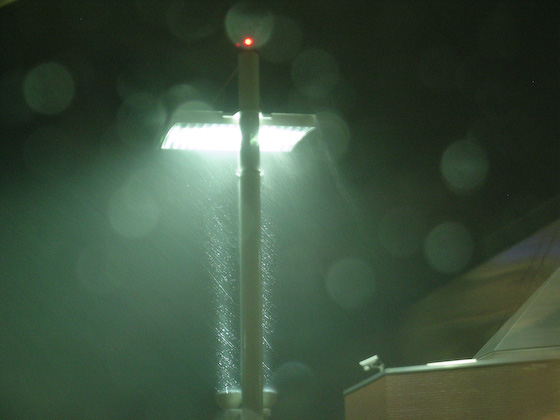Stair Rods

After a quick survey, it seems that there’s not a lot of extreme weather in contemporary art. If you’re looking for the equivalent of the sublime sunsets, sclerotic mists and rousing storms of John Martin or JMW Turner, for instance, you will be sorely disappointed by the dank, flat skies of Mamma Andersson and George Shaw. French theorist Henry Bergson proposed that language prioritises the extreme emotions, that we have words for rage, joy, shame and so on, but we lack the vocabulary for, say, the fusion of vague frustration with abstract hankering. The more common human condition is not of extremes, but in the transitory or liminal regions that cannot be so categorically expressed. The same is not true of weather: we have plenty of words for drizzle, dampness, overcast skies, and so on, and artists are perfectly at ease in depicting such non-descript conditions; whereas they do seem to avoid the extremes of tempests and suchlike. In general, the contemporary painted sky holds back its downpour, forever threatening to dampen atmospheres and alter plans, rather than actually being caught in the act of imposing change.
Perhaps this is a philosophical position on the part of artists, with their post-modern allegiances to moments of potential; but I suspect that it is, more simply, down to the fact that rain is jolly hard to depict. Perhaps the most valiant attempt is by David Hockney in his 1973 painting Rain. Hockney had already tackled the dynamism of water in A Bigger Splash (1967), his almost solid-looking swimming pool releasing a great theatrical splash that sits up stiffly like a still-life arrangement. Rain, on the other hand, devotes its entire surface to the schematic simplification of the behaviour of rain on puddle – or, more likely, pool, judging by its impossible azure colour – to evoke the sense of a holiday resort out of season or a leisure moment thwarted. But if you squint, its concentric circles and diagonal stripes become a repeatable pattern that could easily grace the wall of a mid-20th century civic building with an aesthetic detachment.
The fine-art photographer perhaps has less difficulty with rain, as it is less a test of virtuosity, and an easy signifier of ambience. Robert Doisneau’s carousel in a downpour represents an obvious fleshing out Hockney’s themes of seasonality and romance. Bettina von Zwehl, on the other hand, is more interested in the direct reaction of the human subject to a sudden cloudburst. In her series Rain (2003) she catches the moment of impact of a manmade deluge, with the attitude of each sitter reflecting a range of psychological responses to the same circumstance. The nuanced differences between shoulder tension, the open or closed mouth or eyes give clues as to the subjects’ alertness and sensuality, their indulgent or self-protective impulses. Rain, after all, transforms the state of the individual as well as the landscape. Bill Viola applies this to the social group in The Raft (2004), where he videos a group of people from different racial and socio-economic backgrounds being knocked to the ground by a high-pressure hose. Although an obviously contrived extreme, the piece does communicate the idea of the elements as a great leveller.
Olafur Eliasson’s The Weather Project (2003) at Tate Modern, London, is perhaps the best-known climate synthesis, yet there are lesser-known evocations that are more convoluted in their attempt to conjure weather. Marc Quinn apparently created a rainbow in Cammell Laird Ship Yard, Liverpool. While there is little commentary on and no photographs of this, I heard a rumour that it didn’t really work. Simpler, and altogether more successful, is Keith Wilson’s Puddle. It is difficult to give Puddle a date, as it seems to have been installed on a few occasions and stalled at the proposal stage at others. Presumably digging up the ground to create a puddle was too perverse for some institutions. The idea is elegant though – make a dip in an artificially levelled landscape, such as a pavement, and wait for the rain to fill it to create a sculptural collaboration between human and nature. Equally cunning is Susan Collis’s Without you the world goes on (2007) in an apparently neglected gallery space, where a leaky roof continually drips into a bucket. In fact, the water is pumped through submerged pipes to re-drip into the bucket over and over in what is in effect an underplayed fountain. Rain, then, needn’t be a test of painterly virtuosity. Jack Vettriano can put away his umbrellas as a tool of insinuation, as it is possibly the peripheral effects of rain, its atmospheric, psychological and pragmatic influences that are of more interest, not only for us, the audience to appreciate, but for the artist to find ways of constructing.
Image links
John Martin, The Great Day of His Wrath, c. 1853
JMW Turner, Snow Storm – Steam-Boat off a Harbour's Mouth, c. 1842
Mamma Andersson, Cul-de-Sac, 2006
George Shaw, Ash Wednesday: 7.00am, 2004/5
David Hockney, Rain, 1973
David Hockney, A Bigger Splash, 1967 - Image in Tate Collection, but not online
Robert Doisneau, Le Manege de Monsieur Barre, 1955
Bettina von Zwehl, Rain #2, 2003, Bettina von Zwehl, Rain #7, 2003
Bill Viola, The Raft, video stills, 2004
Olafur Eliasson, The Weather Project, 2003
Keith Wilson, Puddle, installation, CCA Vilnius, 2001
Susan Collis, Without you the world goes on, installation view, Seventeen Gallery, 2007
Jack Vettriano, The Singing Butler
ugly rain art (colouredrain.com)
beautiful rain art (flickr.com)
how to put rain in your photos (neondragonart.com)
use rain to sell things (we-make-money-not-art.com)
broodthaers, la pluie (medienkunstnetz.de)
rain room—is it art or design? (artofrain.com)
make your home beautiful and rainy with a wall-tattoo (wall-art.de)
summer rain on hot tarmac | floor plan | top
